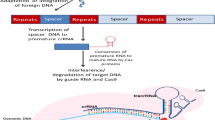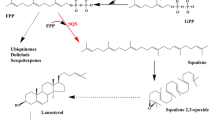Abstract
Isoflavonoids are a diverse group of secondary metabolites derived from the phenylpropanoid pathway distributed mostly in leguminous plants and possess numerous health benefits. Metabolic engineering is a necessary approach for the bioproduction of various secondary metabolites including isoflavonoids. The present study was carried out to engineer the Glycine max Isoflavone Synthase (GmIFS) in indica rice towards the production of the isoflavone genistein. The Agrobacterium-mediated genetic transformation was carried out and transgenic plants were recovered after three rounds of selection and subsequent regeneration and rooting. The presence and stable integration of the transgene were confirmed by PCR and Southern hybridization in both T0 and T1 generations. Biochemical analysis indicated that the transgenic plants recorded higher phenolic, flavonoid, DPPH radical scavenging activity and total antioxidant potential as compared to the wild type (WT). The relative gene expression analysis revealed that the transgenic plants showed higher levels of gene expression as compared to the WT in both T0 and T1 generations. In addition, HPLC analysis revealed enhanced production of the isoflavonoid genistein with transgenic T0 plant IFS7 and T1 plant IFS 7 − 1 recording the maximum genistein content (11.0 µg/g and 8.0 µg/g). Results of the present study indicate that the stable integration of the GmIFS resulted in the enhanced production of isoflavonoid genistein in rice. These results provide evidence that genetic manipulation of isoflavonoid biosynthesis genes could be a viable strategy to enhance the bioproduction of isoflavonoids in non-leguminous plants like rice which could contribute significantly in eliminating nutritional inadequacies.
Key message
• Attempt to engineer the isoflavonoid pathway in rice was found to be successful.
• Transgenic rice plants expressing Glycine max Isoflavone Synthase demonstrated the accumulation of genistein.






Similar content being viewed by others
Data availability
The datasets generated during and/or analysed during the current study are available from the corresponding author on reasonable request.
References
Akashi T, Aoki T, Ayabe SI (1999) Cloning and functional expression of a cytochrome P450 cDNA encoding 2-hydroxyisoflavanone synthase involved in biosynthesis of the isoflavonoid skeleton in licorice. Plant Physiol 121(3):821–828
Banerjee A, Dasgupta N, De B (2005) In vitro study of antioxidant activity of Syzygium cumini fruit. Food Chem 90(4):727–733
Bao J, Cai Y, Sun M, Wang G, Corke H (2005) Anthocyanins, flavonols, and free radical scavenging activity of chinese bayberry (Myrica rubra) extracts and their color properties and stability. J Agric Food Chem 53(6):2327–2332
Bouis HE, Saltzman A (2017) Improving nutrition through biofortification: a review of evidence from HarvestPlus, 2003 through 2016. Global Food Sect. 12:49–58
Brand-Williams W, Cuvelier ME, Berset CLWT (1995) Use of a free radical method to evaluate antioxidant activity. LWT-Food Sci Technol 28(1):25–30
Chu CC (1978) The N6 medium and its application to anther culture of cereal crops. In Proceedings of the Symposium on Plant Tissue Culture, Science Press, Peking, 43–50
Cummings M, Breitling R, Takano E (2014) Steps towards the synthetic biology of polyketide biosynthesis. FEMS Microbiol Letts 351(2):116–125
Deavours BE, Dixon RA (2005) Metabolic engineering of isoflavonoid biosynthesis in alfalfa. Plant Physiol 138(4):2245–2259
Dellaporta SL, Wood J, Hicks JB (1983) A plant DNA minipreparation: version II. Plant Mol Biol Rep 1(4):19–21
Doyle JJ (1990) Isolation of plant DNA from fresh tissue. Focus 12:13–15
Du H, Huang Y, Tang Y (2010) Genetic and metabolic engineering of isoflavonoid biosynthesis. App Microbiol Biotechnol 86:1293–1312
Ferreyra MLF, Rius SP, Casati P (2012) Flavonoids: biosynthesis, biological functions, and biotechnological applications. Front Plant Sci 3(222):2
Hiei Y, Komari T (2008) Agrobacterium-mediated transformation of rice using immature embryos or calli induced from mature seed. Nat Protoc 3:824
Jung W, Yu O, Lau SMC, O’Keefe DP, Odell J, Fader G, McGonigle B (2000) Identification and expression of isoflavone synthase, the key enzyme for biosynthesis of isoflavones in legumes. Nat Biotechnol 18(2):208–212
Latham GJ (2010) Normalization of microRNA quantitative RT-PCR data in reduced scale experimental designs. MicroRNAs and the immune system. Humana Press, Totowa, NJ, pp 19–31
Malla A, Shanmugaraj B, Srinivasan B, Sharma A, Ramalingam S (2020) Metabolic engineering of isoflavonoid biosynthesis by expressing Glycine max isoflavone synthase in Allium cepa L. for genistein production. Plants 10(1):52
Malla A, Shanmugaraj B, Sharma A, Ramalingam S (2021) Production of Genistein in Amaranthus tricolor var. Tristis and Spinacia oleracea by expression of Glycine max isoflavone synthase. Plants 10(11):2311
Misra P, Pandey A, Tewari SK, Nath P, Trivedi PK (2010) Characterization of isoflavone synthase gene from Psoralea corylifolia: a medicinal plant. Plant Cell Rep 29(7):747–755
Murashige T, Skoog F (1962) A revised medium for rapid growth and bio assays with tobacco tissue cultures. Physiol Plant 15:473–497
Nayeem S, Sundararajan S, Ashok AK, Abusaliya A, Ramalingam S (2021a) Effects of cooking on phytochemical and antioxidant properties of pigmented and non-pigmented rare indian rice landraces. Biocat Agric Biotechnol 32:101928
Nayeem S, Venkidasamy B, Sundararajan S, Kuppuraj SP, Ramalingam S (2021b) Differential expression of flavonoid biosynthesis genes and biochemical composition in different tissues of pigmented and non-pigmented rice. J Food Sci Technol 58(3):884–893
Ogo Y, Ozawa K, Ishimaru T, Murayama T, Takaiwa F (2013) Transgenic rice seed synthesizing diverse flavonoids at high levels: a new platform for flavonoid production with associated health benefits. Plant Biotech J 11(6):734–746
Pandey A, Misra P, Bhambhani S, Bhatia C, Trivedi PK (2014a) Expression of Arabidopsis MYB transcription factor, AtMYB111, in tobacco requires light to modulate flavonol content. Sci Rep 4(1):5018
Pandey A, Misra P, Khan MP, Swarnkar G, Tewari MC, Bhambhani S, Trivedi R, Chattopadhyay N, Trivedi PK (2014b) Co-expression of Arabidopsis transcription factor, AtMYB12, and soybean isoflavone synthase, GmIFS1, genes in tobacco leads to enhanced biosynthesis of isoflavones and flavonols resulting in osteoprotective activity. Plant Biotechnol J 12(1):69–80
Pandey A, Misra P, Trivedi PK (2015) Constitutive expression of Arabidopsis MYB transcription factor, AtMYB11, in tobacco modulates flavonoid biosynthesis in favor of flavonol accumulation. Plant Cell Rep 34(9):1515–1528
Pokhrel S, Ponniah SK, Jia Y, Yu O, Manoharan M (2021) Transgenic rice expressing isoflavone synthase gene from soybean shows resistance against blast fungus (Magnaporthe oryzae). Plant Dis 105(10):3141–3146
Shimada N, Akashi T, Aoki T, Ayabe SI (2000) Induction of isoflavonoid pathway in the model legume Lotus japonicus: molecular characterization of enzymes involved in phytoalexin biosynthesis. Plant Sci 160(1):37–47
Sohn SI, Kim YH, Kim SL, Lee JY, Oh YJ, Chung JH, Lee KR (2014) Genistein production in rice seed via transformation with soybean IFS genes. Plant Sci 217:27–35
Sohn SI, Pandian S, Oh YJ, Kang HJ, Cho WS, Cho YS (2021) Metabolic engineering of isoflavones: an updated overview. Front Plant Sci 12:670103
Sreevidya VS, Srinivasa Rao C, Sullia SB, Ladha JK, Reddy PM (2006) Metabolic engineering of rice with soybean isoflavone synthase for promoting nodulation gene expression in rhizobia. J Exp Bot 57(9):1957–1969
Steele CL, Gijzen M, Qutob D, Dixon RA (1999) Molecular characterization of the enzyme catalyzing the aryl migration reaction of isoflavonoid biosynthesis in soybean. Arch Biochem Biophy 367(1):146–150
Subramanian S, Graham MY, Yu O, Graham TL (2005) RNA interference of soybean isoflavone synthase genes leads to silencing in tissues distal to the transformation site and to enhanced susceptibility to Phytophthora sojae. Plant Physiol 137(4):1345–1353
Sundararajan S, Sivaraman B, Rajendran V, Ramalingam S (2017) Tissue culture and Agrobacterium-mediated genetic transformation studies in four commercially important indica rice cultivars. J Crop Sci Biotechnol 20(3):175–183
Sundararajan S, Rajendran V, Nayeem S, Ramalingam S (2020) Physicochemical factors modulate regeneration and Agrobacterium-mediated genetic transformation of recalcitrant indica rice cultivars-ASD16 and IR64. Biocat Agric Biotechnol 24:101519
Sundararajan S, Rajendran V, Sivakumar HP, Nayeem S, Chandra HM, Sharma A, Ramalingam S (2021) Enhanced vitamin E content in an Indica rice cultivar harbouring two transgenes from Arabidopsis thaliana involved in tocopherol biosynthesis pathway. Plant Biotechnol J 19(6):1083
Yu O, Jung W, Shi J, Croes RA, Fader GM, McGonigle B, Odell JT (2000) Production of the isoflavones genistein and daidzein in non-legume dicot and monocot tissues. Plant Physiol 124(2):781–794
Acknowledgements
Safia N thanks University Grants Commission-Basic Science Research, New Delhi for fellowship support (UGC BSR No. F.25.1/2014-15). Author Sathish S acknowledges Indian Council for Medical Research (ICMR), New Delhi (No.3/1/2/102/2018-Nut.) for fellowship support. We acknowledge the University Grants Commission – Special Assistance Programme (UGC-SAP-II: F-3-20/2013) and the Department of Science and Technology -Fund for Improvement of S&T Infrastructure (DST-FIST: SR/FST/LSI-618/2014) for providing infrastructure to carry out this research.
Author information
Authors and Affiliations
Contributions
SN carried out the experiments and prepared the manuscript, SS contributed to experimental analysis, manuscript preparation, and data representations. VR contributed to data analysis and representations, AM carried out the initial cloning experiments in IFS, AS contributed to experimental analysis, manuscript evaluation and SR conceptualized, supervised the research, and critically evaluated the manuscript.
Corresponding author
Ethics declarations
Conflict of interest
All authors read, approved the manuscript, and declare that there is no conflict of interest.
Additional information
Communicated by Manoj Prasad.
Publisher’s Note
Springer Nature remains neutral with regard to jurisdictional claims in published maps and institutional affiliations.
Rights and permissions
Springer Nature or its licensor (e.g. a society or other partner) holds exclusive rights to this article under a publishing agreement with the author(s) or other rightsholder(s); author self-archiving of the accepted manuscript version of this article is solely governed by the terms of such publishing agreement and applicable law.
About this article
Cite this article
Nayeem, S., Sundararajan, S., Rajendran, V. et al. Metabolic engineering of isoflavonoid genistein in indica rice by expressing Isoflavone Synthase from Glycine max. Plant Cell Tiss Organ Cult 155, 243–253 (2023). https://doi.org/10.1007/s11240-023-02577-5
Received:
Accepted:
Published:
Issue Date:
DOI: https://doi.org/10.1007/s11240-023-02577-5




